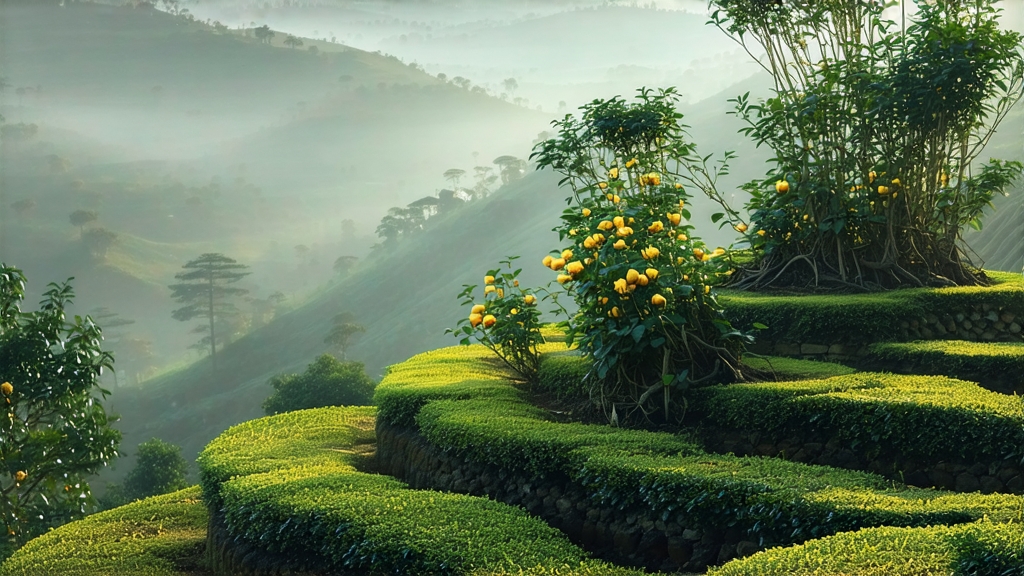
Tucked high above the Sichuan basin where the Min River cuts through perpetual cloud, Meng Ding Huang Ya has been quietly perfecting its golden character for twelve centuries. Foreign drinkers often meet yellow tea as a curiosity—neither green freshness nor black depth—yet this single bud-and-leaf plucked from 1,200-year-old gardens on Meng Ding Shan embodies the style’s most regal and elusive expression. To understand it is to witness Chinese tea craft at its most precarious: a dance of timing, humidity and instinct that can turn imperial tribute into mere withered leaf overnight.
History: from palace secret to mountain heirloom
The first written record appears in 808 CE when the Tang dynasty Salt & Tea Commission listed “Mengshan Huangya” among the eight teas acceptable as imperial tax. During the Song, Buddhist monks on the summit traded the tea for printed sutras, spreading its fame along the Tea-Horse Road. By Ming times the buds were wrapped in yellow silk, carried 1,800 km to Beijing and presented to the emperor at the Lantern Festival; commoners caught possessing it faced flogging. When the Qing court shifted to darker Wuyi rock teas, Meng Ding Huang Ya retreated into local memory, surviving only because hill farmers kept seed gardens for their own weddings and ancestral rites. Not until 1959 did a government expedition rediscover ancient bushes under wild kiwi vines; cuttings were propagated, and the tea re-entered commerce as one of China’s Ten Famous Teas, yet annual production still hovers below three tonnes—rarer than the finest Da Hong Pao.
Micro-terroir: why the mountain makes yellow
Meng Ding Shan, “the misty peak,” rises to 1,456 m inside the western edge of the Sichuan basin. Warm, moist air from the Min River meets the cold Tibetan Plateau breeze, forming a 200-day fog blanket that filters sunlight into a soft, blue-white glow. The bushes, mostly seed-propagated descendants of the original Tang cultivar, grow slowly on weathered purple sandstone. Night temperatures drop 10 °C, locking amino acids into the buds; morning mist rehydrates them, creating an unusually high theanine-to-catechin ratio that translates into the tea’s hallmark sweet corn silk note. Soil drains quickly, forcing roots to dive three metres, drawing up trace selenium and vanadium that broaden the cup’s texture to a velvety, almost lanolin finish.
Pluck: one bud, one leaf, 2.3 cm of perfection
The harvest window opens for only ten days around Qingming (early April) when the bud reaches 15 mm—what locals call “parrot beak” shape. Pickers climb bamboo ladders at dawn while the mountain is still invisible, selecting only the pair whose second leaf is half-unfurled, small enough to nestle inside the bud like a closed fan. A skilled woman can finish 600 g fresh leaf by breakfast; five kilos are needed for one kilo of finished tea, translating roughly to 32,000 plucks.
Craft: the secret “sealed yellowing”
Yellow tea’s identity rests on a unique micro-fermentation step men huan—“sealed yellowing”—that oxidises leaf pigments gently without the microbial assault of sheng pu-erh. Meng Ding Huang Ya undergoes two cycles, each a 48-hour high-wire act.
-
Sha Qing (kill-green): 180 °C bamboo-roasted wok, 4 min
The tender shoots are tossed in a wok lined with fresh bamboo skin; the bamboo’s natural oils coat the leaf, locking in a green-yellow hue and adding a whisper of toasted bamboo sap that later emerges as crushed sugarcane aroma. -
Re-wrap & heap: 50 °C, 85 % RH, 40 min
The just-roasted leaf is immediately wrapped in thick linen, trapping residual heat and moisture. Chlorophyll begins to break down; catechins dimerise, rounding astringency. -
First men huan: sealed in oak boxes, 28 °C, 12 h
Leaf is spread 3 cm deep inside 30 kg oak tea boxes lined with wet parchment. The wood’s tannins donate a faint vanilla note while polyphenol oxidase edges the leaf toward a lemon-yellow. Masters listen for a soft rustling—when the leaf whispers, oxidation is complete. -
Re-firing: 120 °C, 2